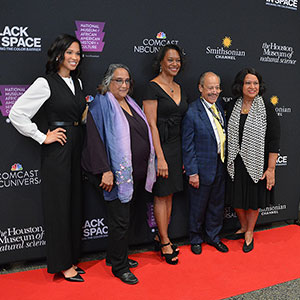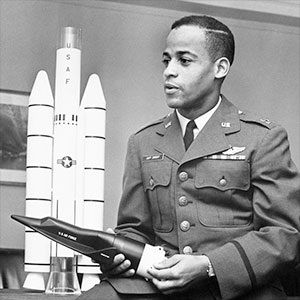February 24, 2020 — The intersection between race and the space race is the focus of a new documentary profiling the first African American astronauts.
"Black in Space: Breaking the Color Barrier," which premieres on the Smithsonian Channel on Monday (Feb. 24), chronicles the historical efforts by the United States and the former Soviet Union to launch the first black astronaut into space.
"I was curious about the intersection of the civil rights movement, the space race and the Cold War," Laurens Grant, director and producer of "Black in Space," said in an interview. "In talking to scholars, a lot of them told me that, in a way, this was almost fresh research."
"We know so much about the civil rights movement, the space race and the Cold War, but not a lot of people concentrate and focus on all three in one," said Grant.
The Space Age began with the launch of the world's first satellite on Oct. 4, 1957, exactly one month to the day after classes were set to begin at Central High School in Little Rock, Arkansas. That day, nine African American students were blocked by soldiers from entering the school on the order of the state's governor, who was opposed to desegregation.
"With the 'Little Rock Nine' trying to go to high school — just black kids trying to go to an all-white school — all of the vitriol and blowback happened at the same time that the Russians blasted off with Sputnik. And so they [the Soviets] intentionally made mention in their press that Sputnik was happening at the same time that the United States was going through Little Rock, sort of a thumb in the eye, if you will," said Grant.
"I wanted to set the clock and the tone of the film right there," she said. "So you think, 'Oh, that's interesting, all of those things are happening right at once,' and then hopefully take you on a ride through all of the firsts, when we finally get the first African American astronauts making history."
The hour-long documentary features archival footage and new interviews with the NASA and Interkosmos crew members whose trailblazing experiences first brought diversity into orbit. The film opens with the story of Edward Dwight, a U.S. Air Force test pilot who was the first African American to be eligible to become a NASA astronaut.
At the urging of the Kennedy administration, which saw the political benefits of a diversified astronaut corps, Dwight was assigned to the Aerospace Research Pilot School at Edwards Air Force Base in California, where, in 1962, the press labeled him the country's "first black astronaut."
"I was swept off my feet, being a kind of introverted, apolitical personality," Dwight said in an interview with collectSPACE prior to a Feb. 4 screening of "Black in Space" at the Houston Museum of Natural Science in Houston, Texas. "The next thing you know, I'm on magazine covers all over the world and getting 1,500 letters a day from people congratulating me — and I hadn't done anything yet."
Despite the headlines, Dwight never flew in space, or became an astronaut.
"You can almost draw a graph of it," said Dwight, who today is a celebrated sculptor. "Everything was working and the graph was on an upward trajectory until Nov. 22, 1963, when the president [Kennedy] was killed. It changed the whole play. The whole thing was turned on his head and all of a sudden, I found myself without a sponsor and was lost in the hinterlands."
Four years later, after Dwight separated from the Air Force, Robert Lawrence became the first African American to be chosen for a space program, the U.S. Air Force's Manned Orbiting Laboratory (MOL). Tragically, he died in a jet crash on Dec. 8, 1967, just six months after his selection.
As "Black in Space" explains, it then took another 11 years before the next black astronauts were in a position to finally leave Earth. In 1978, NASA recruited its first three African American trainees, including Guion "Guy" Bluford, who ultimately became the first black astronaut to lift off on a U.S. space shuttle in August 1983.
But he was not the first black in space. As it had with the world's first man and first woman, the Soviet Union launched the first person of African heritage three years before Bluford's flight.
"The objective here wasn't to be the first black person in space, it was just a reality," Soyuz 38 cosmonaut Arnaldo Tamayo Méndez says in an interview filmed in his home country of Cuba in "Black in Space."
Grant concludes the documentary with a quick look at the African Americans that followed Tamayo and Bluford into space. Over the past 40 years, 17 more black astronauts have joined NASA, of which three women and 10 men have flown into space.
"I looked back at the black press way back in the '50s and African Americans were very interested in wanting to participate. They wanted to be involved in the space race — and we should, as well as anyone who wants to, should be involved in space exploration," said Grant. "Hopefully, looking at the documentary, if you're a kid you can say that this is achievable."
"Black in Space: Breaking the Color Barrier" debuts on the Smithsonian Channel at 8 p.m. EST on Monday (Feb. 24), and then re-airs at 11 p.m. and at 10 a.m. on Thursday (Feb. 27). The full documentary is also available to stream on Apple TV, Amazon Prime, Roku and on YouTube. |
|

"Black in Space: Breaking the Color Barrier" tells of the decades-long race between the U.S. and the Soviet Union to be the first nation to bring diversity to the skies, told by the black astronauts and their families. (Smithsonian Channel)

KHOU anchor Mia Gradney, National Air and Space Museum curator Cathleen Lewis, director and producer Laurens Grant, U.S. Air Force aerospace research pilot Capt. Ed Dwight and Cheryl McNair, widow of Challenger STS-51L astronaut Ron McNair at the premiere of the Smithsonian Channel documentary "Black in Space: Breaking the Color Barrier" on Feb. 4, 2020 at the Houston Museum of Natural Science in Houston, Texas. (collectSPACE)

U.S. Air Force test pilot Edward Dwight became the first African American to graduate from the Aerospace Research Pilot School at Edwards Air Force Base in California and become eligible for selection by NASA as an astronaut. Ultimately, he was not chosen and left the Air Force to become a celebrated sculptor. (USAF) |
